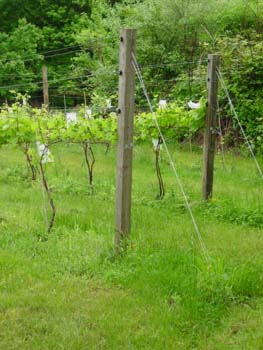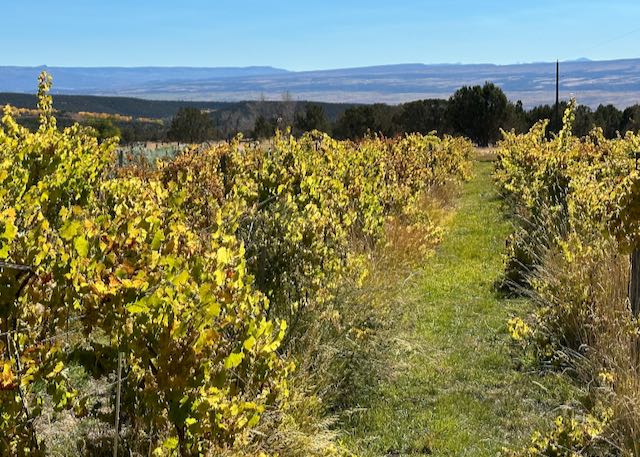Planning Your Backyard Vineyard (WineMaker)

With all the excitement of harvest and crush in the air, it’s easy to forget about planting.
But if you’d like to start a small, backyard vineyard next spring, there are some important things to do before winter arrives.
It’ll make it easier to get your vines in the ground when the weather warms up.
The most important elements in any vineyard development project are research and resources. And the most important resources are other grape growers. Try to find folks in your region who are growing decent grapes. Then bring them some good wine and ask as many questions as they’re willing to answer.
When and what did they plant? Are the vines on their own roots or special rootstock? What resources — favorite books, local growers or nurseries, the county agriculture department — do they use? How much and when do they water? When and what do they apply to the grapes to control mildew, rot or insects? Is there a local university or community college, like UC Davis in California or Cornell in New York, that offers courses on vine growth?
Once these preliminary questions are answered, you’re ready to start planning your backyard vineyard.
How Will Your Vineyard Grow?
Here are ten questions you’ll need to answer before you plant your vines next spring. The more research you do at the beginning of your project, the less backpedaling and problem-solving you’ll have to do once the vineyard is growing and producing.

1. Have I done soil samples to check for available nutrients and potential soil problems?
This is pretty easy — just grab a shovel and dig a nice deep hole (up to three feet for a good sample of subsoil) where you plan to grow some grapes. Once the hole is dug, scrape soil off the side of the hole into a large Ziploc bag. Scrape soil from 1 to 12 inches into one labeled bag, and scrape some soil from two feet and deeper into another labeled bag.
Consult your local Agriculture Extension Office (county branch of USDA) for a laboratory that can evaluate the soil for wine grapes. Soil samples will alert you to nutrient problems before planting. A neutral pH, around 7, is optimal. Lower pH is considered acidic, higher is considered alkaline. If the soil has always produced healthy vegetation or vegetables, chances are vines will do fine in that ground. Rich soil tends to produce herbaceous flavors, clay is to be avoided, well drained soil and sandy loam is best.
2. How will my local weather impact my vines?
You ideally need between 150 to 200 frost-free days to produce mature vitis vinifera fruit. This classic wine-grape family includes renowned varietals like Chardonnay, Merlot and Cabernet Sauvignon. A lot depends on the timing the last frost. Pinot Noir, Gewirztraminer and Riesling do better in later frost areas and Chardonny, Merlot and Cabernet, need 190 frost free days or more. If your climate is less than ideal, you should select something from the hardy North American vitis labrusca. family or try hybrid vines, such as Norton, Chardonnel, Chancellor, or Baco Noir.
The key is to find what your neighbors are planting and what vines produce the best wines. If you can’t find any local winegrape growers, call a few nurseries and make inquiries about what varieties of grapevines might do well in your backyard.
To make sweeping generalizations, vitis vinifera thrives in the West and Northwest. It also does well in selected locations in the Southwest, Midwest and Northeast (a prime example is the fine white wine from Michigan and New York, where lakes tend to moderate the climate). Vinifera has also showed limited success in niches not normally known for quality vinifera production. From Virginia to Pennsylvania and Maryland, many growers are having limited success with small vineyards. I even received an e-mail a year back from a gentleman who mule-farms Pinot Noir in Kentucky. Talk about a challenge! Due to hard winters, Canada grows mostly vitis labrusca, but microclimates in the lake Erie and Ontario regions produce Chardonnays and Rieslings and British Columbia produces some top rate dessert wines. Most good vineyards in the East seem to lie within a rough triangle that extends from Rochester, New York (in the northeast) to Virginia (in the south) and Martha’s Vineyard (on the eastern seaboard). As a vinifera grower in California, my expertise in the area of v..labrusca and hybrids is limited. Again, local experts should be sought out and bribed with fine wine.
3. How cold does it get in winter?
Without severe pruning and mounding soil over vines, very cold temperatures will kill vinifera grapevines. In vinifera varieties without a lot of mature fruiting wood, temperatures under 20° Fahrenheit may kill and injure buds and canes. If it gets really cold in winter, you may want to choose hybrid vines that can tolerate cold winters. Foch, for example, has been known to survive temps as cold as –20° F.
Vines do need some cold weather every year to be healthy. All vines have a chilling requirement — if it doesn’t get cold in winter, the vines will not go dormant, and will eventually just give up and die. Finding the right vine for your climate is as easy as finding some local growers or a friendly nurseryman and asking for some helpful advice.
Heat is also a consideration. Photosynthesis maxes out at about 87° F. Super high temperatures can scorch plants, dry the grapes and make it difficult for a vine to respire and thrive. The best wines in the world are grown at the coolest edge of their climate zone.
4. What pest challenges will I face?
Check with your local Ag. Extension office and ask what pests currently reside in your area. What insects are likely to feed on your vines? Do any of them carry disease, and if so, how can you protect your vines from infection?
If you live in an area with wild pigs, deer, rabbits or large flocks of starlings — and you have no fencing or netting — I would dissuade you from wasting time and effort on a vineyard that will do nothing but feed wildlife. Are there gopher mounds every five feet? Better start trapping (or do some research to devise a more humane approach).
Perhaps there are beneficial insects that can be released into your vineyard early, so when you plant there will already be a healthy population of “good bugs” to fight off the “bad” ones. Lacewings, praying mantises, spiders, lady beetles and other beneficial insects can be released in lieu of pesticides. In the long run, pests become resistant to chemicals and harder to kill.
5. Is your soil infested with nematodes or the root-louse phylloxera?
I might sound like a broken record at this point, but local growers and your Ag Extension office can help you find out. If so, you might want to choose a rootstock (such as 5C, 101-14 or110 R) that is resistant to these pests. Rootstock is basically the “bottom half” of a grafted vine — viticulturists commonly use the hardy roots of an American vine grafted on to a vinifera “top.” This way you get the benefits of a pest-resistant root system and the fruit of a European vinifera variety. Vines are usually grafted by the nursery, and can be ordered in any combination imaginable. If you are lucky enough to be free of these pests, vines can be planted on their own roots.
6. How are the vines to be irrigated?
Is my water clean and usable for agriculture? If you’re a perfectionist, you can have you water tested (many companies test water; look in the yellow pages under a category like “laboratories — testing.”) In general, hose water will be appropriate for a home vineyard.
Applying the water through the ground or by “drip irrigation” is much more efficient than by sprinkler. Try to keep water off the fruit and vines; otherwise you might have problems with rot and mildew. Do not over water. Wine grapes like just enough water to keep alive. Do not early water before May 1st, or the vines can produce leaves but no grapes.
7. Can the land be cleared in a way that is legal and will not upset the natural balance of the site? Is your site erosive?
Remember that keeping the land healthy and full of biodiversity will help your vines help themselves. Nature attacks the weak. You want your vineyard to be healthy enough that pests will look for easier pickings.
8. How much crop do I need for my winemaking?
At five pounds of crop per plant (assuming low to moderate yield), you will need 200 to 250 vines to assure that in a “regular” year you’ll have enough fruit for one 60-gallon barrel of wine plus extra for topping. You can use this ratio (250 vines = 60 gallons) to figure approximate wine yield. Different vines and different soils produce different crop levels, obviously. You may well be able to push more yield from your vines.
Another rule of thumb is that you need approximately 20 pounds of fresh fruit for each gallon of homemade wine. If each vine produces five pounds and you’d like to make one five-gallon batch from your own grapes each year, then plant 20 vines (plus a few extra, just in case).
9. How am I going to trellis my vines?
This is a difficult question. I recommend ordering a few vines a year early and doing a test plot to see how the vines react to your soil, climate and water. Low vigor sites (mature shoots are less than 6 feet tall) are easily managed with a “vertical shoot” system (sets of wires to direct all shoot growth straight up), while high-vigor sites (mature canes are in excess of 6 feet) may be left to ‘sprawl’ on a common wire trellis. They can be trained onto a more complicated trellis system; you’ll find these described in many viticulture reference books (see “Grape Growing Resources” at end of story).
10. How am I going to orient my vineyard?
I am a big fan of fruit grown on tight spacing — less than eight feet between rows and less than 4 feet between plants — with southwest exposure. Close spacing encourages less vigor and more competition.
Exposure is increasingly important. In places where the climate is almost too cool to ripen a crop; the exposure to sunlight can compensate for cool weather.
Getting Your Hands Dirty
Suppose you have read the previous warnings, answered the questions and researched your area. You’re armed with all the information you need to start growing your own wine grapes. Here’s yet another list to tackle before the first hard frost.
* A greater percentage of WineMaker’s content is behind a paywall. If you are new to viticulture and/or winemaking, having a subscription for less than $50 annually is paramount. The resources WM provides are unparalleled, providing workshops, conferences, and online archival access to articles.
All geared to the hobbyist!


